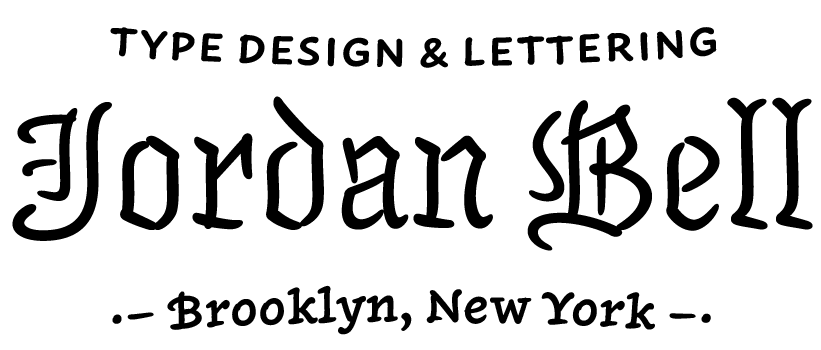My former classmate, and good friend, Megan Teel recently asked me whether she should pursue a intensive study on hand lettering or type design. I started answering the question but soon realized it’s a more complex issue. I wanted to share my thoughts on the subject below.
First of all, I believe both of these subjects are noble and difficult forms of design. I also would like to think I have experience in both since I did much hand lettering in college and am now studying type design at Reading University. But to answer which one a designer should choose to pursue is difficult for many reasons.
My answer depends largely on what you qualify as “hand-lettering”. It is such an ambiguous word. Hand lettering can mean drawing grungy lettering with a pencil or ballpoint pen (like what I did in college lol) or creating custom made, high quality, digitally drawn logos. The former of these two styles is a fad. I think many designers will say the same. People really dig the hand-made, quick, rustic aesthetic currently, but companies and clients are always going to want what is vogue at the moment. You can see this in the clients that I have worked for in the past. Many just want what is cool and trendy, pay me quick, then they are on their way to the next job. It’s business, we have to embrace that. But that’s why we must not only single ourselves out as a one-trick pony. We should strive to create great timeless design that can be attractive to many different clients because of our critical eye for detail and typography.
However, my guess is custom lettering will never go away. Many designers (me included) and firms do custom lettering. It has been a profession for hundreds of years. Since way before the first digital font, before Gutenberg created moveable types for his press, and even before the scribes “hand lettered” one bible for years, people have been creating lettering.
All of this leads to the next option – Creating type design. Custom type in many ways is hand lettering that can function as “type” for a specific reason or client. Creating “functional” typefaces is an even more difficult task though than just creating a few letters or words for a brand. I think putting restraints on yourself to develop something that actually has to work as type for many different mediums and people instead of just creating lettering for an aesthetic choice is respectable, but not better. Both have their merits. Learning new programs on the computer can never really harm you either. Getting a feel for Glyphs, Robofont, or any other design software for that matter, will only broaden your perception on what lettering, type, and typography is.
Learning about the history of typography and creating type design will push the designer to create more beautiful letterforms through the ability to notice details in the design. This will help any designer to have a greater knowledge of letters and the reasons why they are made, thus helping the designer create beautiful designs and solutions for a whole slew of media. This knowledge and practice of typography could be manifested in hand lettered posters, logos, web type, packaging, custom typefaces for a company, ornamental monograms, or just the ability to distinguish good fonts from bad.
Also of course you have to think about your own perspective. Why do you want to design type or lettering? What are the ends to this incredibly complex means? Do you want to create calligraphy for wedding cards, or a branding for your favourite local eatery, or a workhorse text face for a scientific magazine? There are so many different fields and branches of lettering/type design that it is hard to answer the initial question: which direction to choose, hand lettering or type design. A knowledge about the design and history of letterforms and graphic design will undoubtedly lead the designer to better typographic solutions whichever path they choose.
This is the same question I was asking myself while I was in college. I ended up with the thought that leaning about the history of type and graphic design and practicing drawing everyday will help me create beautiful typography and design no matter what medium or client. And that’s why I am here at Reading University studying Type Design and Typography!
My advice is this. Get out a sketchbook and start drawing crazy letters with all sorts of weird pens and pencils. Maybe you’ll enjoy it. I know it’s my favorite thing to do.
